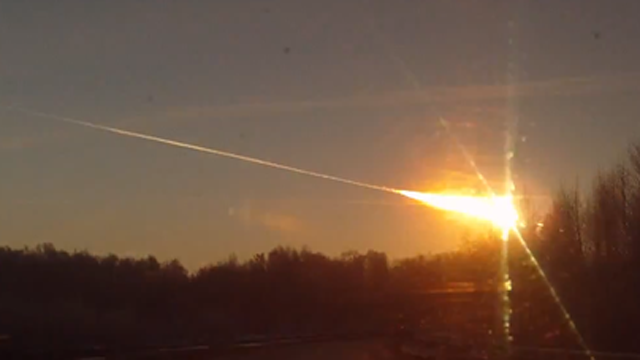

| Visitors Now: | |
| Total Visits: | |
| Total Stories: |

| Story Views | |
| Now: | |
| Last Hour: | |
| Last 24 Hours: | |
| Total: | |
Russian Meteor Heard In Georgia Ten Hours After Explosion
This video shows infrasound signals associated with the Russian meteor impact on February 15, 2013, recorded nearly 9,600 km away in Lilburn, Georgia. The sound took about 10 hours to travel from Russia to Georgia. The seismic data is distributed by the IRIS DMC, TA/USArray network.
Lilburn is home to one of nearly 400 USArray seismic/infrasound stations in use in the eastern United States. They are part of a large-scale project named “Earthscope,” an initiative funded by the National Science Foundation that studies the Earth’s interior beneath North America. The stations are mainly deployed to record seismic waves generated from earthquakes, but their sound sensors can record ultra long-period sound waves, also known as infrasound waves.
The human ear cannot hear these infrasound signals. However, by playing the data faster than true speed, Georgia Tech faculty member Zhigang Peng increased the sound waves’ frequency to audible levels. The Incorporated Research Institutions for Seismology’s Data Managment Center provided the data.
“The sound started at about 10 hours after the explosion and lasted for another 10 hours in Georgia,” said Peng, an associate professor in the School of Earth and Atmospheric Sciences. He’s confident that the sound is associated with the meteor impact because a slow propagation of the sound waves can be seen across the entire collection of USArray stations, as well as other stations in Alaska and polar regions.
This video shows seismic signals associated with North Korea’s nuclear test on February 12, 2013 in comparison to signals from a 5.1 earthquake in Nevada the next day. The seismic data is distributed by the IRIS DMC, TA/USArray network.
“They are like tsunami waves induced by large earthquakes,” Peng added. “Their traveling speeds are similar, but the infrasound propagates in the atmosphere rather than in deep oceans.”
Scientists believe the meteor was about 55 feet in diameter, weighed more than 7,000 tons and raced through the sky at 40,000 miles an hour. Its energy was estimated at 30 nuclear bombs. More than 1,500 people were hurt.
Using the same sonification process, Peng also converted seismic waves from North Korea’s nuclear test on February 12 and an earthquake in Nevada the next day. Each registered as a 5.1 magnitude event but created different sounds. The measurements were collected by seismic instruments located about 100 to 200 miles from each event. For further comparison, Peng has also created a seismic recording of the meteor impact at a similar distance.
“The initial sound of the nuclear explosion is much stronger, likely due to the efficient generation of compressional wave (P wave) for an explosive source,” said Peng. “In comparison, the earthquake generated stronger shear waves that arrived later than its P wave.”
Peng says the seismic signal from the meteor is relatively small, even after being amplified by 10 times. According to Peng, this is mainly because most of the energy from the meteor explosion propagated as the infrasound displayed in the initial sound clip. Only a very small portion was turned into seimsic waves propagating inside the Earth.
This isn’t the first time Peng has converted seismic data into audible files. He also sonified 2011′s historic Tohoku-Oki, Japan, earthquake as it moved through the Earth and around the globe.
The seismic and sound data generated by the meteor impact and other sources can be used to demonstrate their global impact. Scientists are also using them to better understand their source characterizations and how they propagate above and inside the earth.
Contacts and sources:
Georgia Institute of Technology.
2013-05-03 13:45:35
Source: http://nanopatentsandinnovations.blogspot.com/2013/05/russian-meteor-heard-in-georgia-ten.html
Source:



